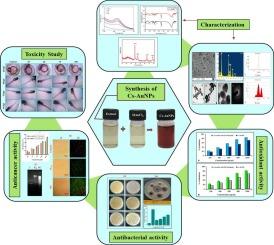Biogenic gold nanoparticles synthesized from Caulerpa sertularioides: A green approach for antioxidant, antibacterial and anticancer applications
IF 4.7
2区 医学
Q1 BIOCHEMISTRY & MOLECULAR BIOLOGY
引用次数: 0
Abstract
This research used an aqueous extract from Caulerpa sertularioides to convert gold ions, demonstrating the eco-friendliness, low toxicity, and cost-effectiveness of green nanoparticle synthesis. The formation of C. sertularioides-mediated gold nanoparticle (Cs-AuNPs) was authenticated by the UV–visible absorption peak at 538 nm. FT-IR identified functional groups responsible for reducing gold ions to Cs-AuNPs. XRD and electron microscopy (FESEM and HR-TEM) confirmed the face-centered cubic (fcc) structure and spherical shape, averaging 26.3 nm in size. The synthesized Cs-AuNPs were evaluated for antioxidant, antibacterial, and cytotoxic properties. Cs-AuNPs demonstrated a dose-dependent antioxidant activity. The antibacterial assay on Photobacterium damselae showed a concentration-dependent effect, with the highest activity of 21 mm at 100 μg/mL. The MTT experiment showed significant cytotoxic activity against HT-29 cells, with an IC50 of 15.44 μg/mL. Additionally, Cs-AuNPs exhibited no toxicity toward zebrafish embryos. These results suggest that C. sertularioides may serve as a sustainable source for producing AuNPs, which hold promise for biomedical applications as antibacterial and anticancer agents.

从sertularioides合成的生物金纳米颗粒:抗氧化、抗菌和抗癌的绿色途径
本研究利用sertularioides的水提取物转化金离子,证明了绿色纳米颗粒合成的生态友好性、低毒性和成本效益。538 nm处的紫外可见吸收峰证实了金纳米颗粒(Cs-AuNPs)的形成。FT-IR鉴定了负责将金离子还原为Cs-AuNPs的官能团。XRD和电镜(FESEM和HR-TEM)证实了该材料的面心立方(fcc)结构为球形,平均尺寸为26.3 nm。对合成的Cs-AuNPs进行抗氧化、抗菌和细胞毒性评价。Cs-AuNPs表现出剂量依赖性的抗氧化活性。对豆色光杆菌的抑菌效果呈浓度依赖性,在100 μg/mL浓度下,其抑菌活性最高达21 mm。MTT实验显示其对HT-29细胞有明显的细胞毒活性,IC50为15.44 μg/mL。此外,Cs-AuNPs对斑马鱼胚胎没有毒性。这些结果表明,sertularioides可能是产生AuNPs的可持续来源,其作为抗菌和抗癌药物在生物医学应用中具有前景。
本文章由计算机程序翻译,如有差异,请以英文原文为准。
求助全文
约1分钟内获得全文
求助全文
来源期刊

Bioorganic Chemistry
生物-生化与分子生物学
CiteScore
9.70
自引率
3.90%
发文量
679
审稿时长
31 days
期刊介绍:
Bioorganic Chemistry publishes research that addresses biological questions at the molecular level, using organic chemistry and principles of physical organic chemistry. The scope of the journal covers a range of topics at the organic chemistry-biology interface, including: enzyme catalysis, biotransformation and enzyme inhibition; nucleic acids chemistry; medicinal chemistry; natural product chemistry, natural product synthesis and natural product biosynthesis; antimicrobial agents; lipid and peptide chemistry; biophysical chemistry; biological probes; bio-orthogonal chemistry and biomimetic chemistry.
For manuscripts dealing with synthetic bioactive compounds, the Journal requires that the molecular target of the compounds described must be known, and must be demonstrated experimentally in the manuscript. For studies involving natural products, if the molecular target is unknown, some data beyond simple cell-based toxicity studies to provide insight into the mechanism of action is required. Studies supported by molecular docking are welcome, but must be supported by experimental data. The Journal does not consider manuscripts that are purely theoretical or computational in nature.
The Journal publishes regular articles, short communications and reviews. Reviews are normally invited by Editors or Editorial Board members. Authors of unsolicited reviews should first contact an Editor or Editorial Board member to determine whether the proposed article is within the scope of the Journal.
 求助内容:
求助内容: 应助结果提醒方式:
应助结果提醒方式:


